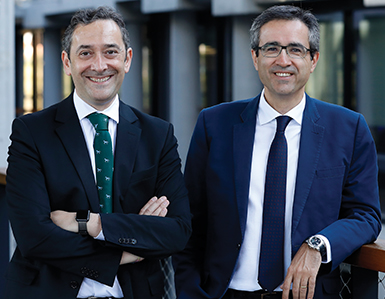BBVA has enjoyed a recent turnaround in fortunes, cutting its bad loans and boosting its capital adequacy ratios. In 2018, as part of a commitment to sustainable issues, the bank launched a $1bn green bond to widespread interest. David Wigan reports.
For BBVA, and the Spanish economy it operates within, things keep getting better. The bank’s declining rate of non-performing loans (4.4% in March 2018 compared with 4.9% the previous year) and falling cost of risk reflect a national economy that has grown by more than 3% over the past three years, well above the eurozone average.
Over the past few months, rating agencies Moody's, Standard & Poor’s and Fitch have all upgraded Spain’s debt ratings. Sovereign borrowing costs have fallen sharply and unemployment is down from 26% in 2013 to 16% today. According to an observation in April by Alberto Nadal, who was the secretary of state for budgets for the then ruling Popular party, the present represents “the greatest economic period in Spanish history”.
BBVA may lay claim to a similar sense of exhilaration, with the bank casting off the effects of Spain's 2012 economic turmoil, in which toxic loans to property developers left some banks insolvent, leading to an eventual €100bn eurozone bailout. Just six years later, the bank is the picture of financial health, with €685bn of assets, rising net interest income and strong capital and liquidity ratios.
Boosting its reserves
BBVA has also taken steps to ensure it is ahead of the game in complying with new European rules on loss-absorbing capital, lifting its additional Tier 1 ratio to 1.65% (above the 1.5% minimum) and its Tier 2 ratio to 2.55% (compared with a minimum of 2%). In recent months it has been able to put in place the final piece of the puzzle, after receiving guidance from the Bank of Spain on its requirement for minimum requirement for own funds and eligible liabilities (MREL), designed to ensure banks have sufficient resources to cover losses and recapitalisation needs in a resolution.
From 2020, BBVA must hold MREL equivalent to 15.08% of total liabilities and own funds of its resolution group as of December 31, 2016. This equals 28.04% of risk-weighted assets, which the bank calculates at €207bn (in the European perimeter).
“We are in fact already compliant with this requirement, so our funding strategy now is to substitute maturing senior preferred debt and covered bonds with MREL-compliant senior non-preferred, so we ensure we stay compliant heading into 2020,” says Antonio Borraz, BBVA’s global head of asset and liability management and treasurer.
A Spanish first
The bank expects to replace about €9bn of senior preferred and covered bond maturities up to 2020. Of that total, it has sold €2.5bn of senior non-preferred maturities in 2018, including a five-year €1.5bn floating rate bond in February. It followed up in May with a seven-year senior non-preferred green bond, the first of that type of instrument to be issued by a Spanish bank.
“The bank made a commitment in February to mobilise €100bn up to 2025 to support green finance, sustainable infrastructure, agribusiness and financial inclusion, based on the UN’s Sustainable Development Goals,” says Mr Borraz. “We have commitment across the whole group.” BBVA generates about 61% of its gross income from emerging markets, where it holds about 39% of its assets.
To show its commitment to the new programme, the bank elected to exceed the usual €500m benchmark and go for a €1bn issue, which reflected its already strong commitment to green projects and would allow for about €200m of new credit provision. It would also be the largest green bond ever issued by a eurozone financial institution.
“We focused only on green assets and wanted to have the bond identified as only green, rather than incorporating the other sustainable goals,” says Mr Borraz.
No roadshow
The deal was led by BBVA and supported by Société Générale, Crédit Agricole, Commerzbank and HSBC. The team aimed to go to market soon after the end of the bank’s first-quarter blackout period, which ended on April 27. Unusually, BBVA opted against a roadshow, relying instead on the disclosure earlier in April of its issuance framework.
“Given the recent volatility in the financial markets, we did not want a big gap between the announcement and pricing,” says Ignacio Echevarría, BBVA’s head of wholesale funding and capital operations. “We wanted intra-day execution.”
On the day of the transaction, the bank announced the deal at 9am with initial price talk set at mid-swaps plus 95 basis points (bps). The book reached €1bn in the first hour and quickly rose to €3bn, comprising some 240 separate orders. Pricing was tightened to mid-swaps plus 80bps, with little impact on demand, and the final book was about €2.8bn.
“We priced in line with secondary, without any new issue premium concession,” says Mr Echevarría. “That’s pretty impressive and reflects the demand for green bonds from specialist and general investors.”
One notable aspect of the book was the high proportion of French money managers, which accounted for about 40% of the total, and some 80% of the specialist green investor group. “We saw a huge participation from green investors, most of them French, suggesting the green format was a huge driver of the success of this deal,” says Mr Echevarría. “This is something we are going to develop and we expect to come back with another green, sustainable or social bond once a year, and for our subsidiaries to issue for themselves.”



